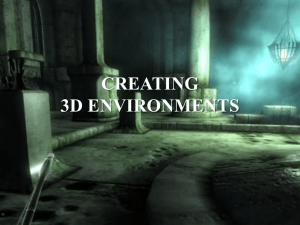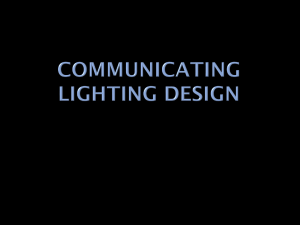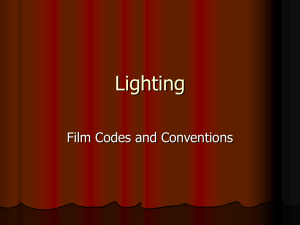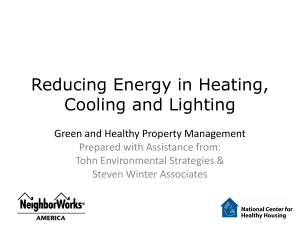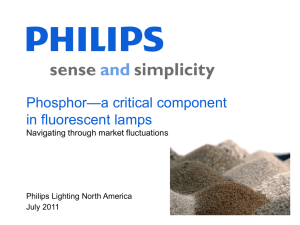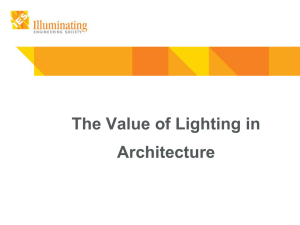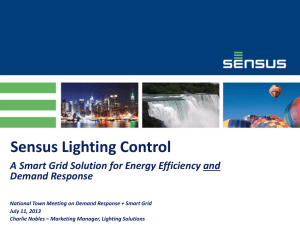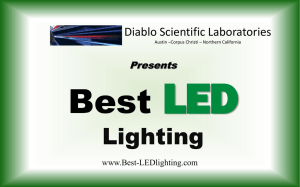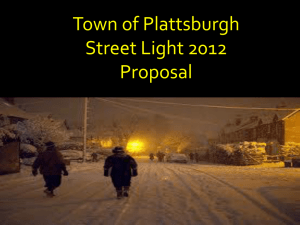here - InfinitiEP
advertisement
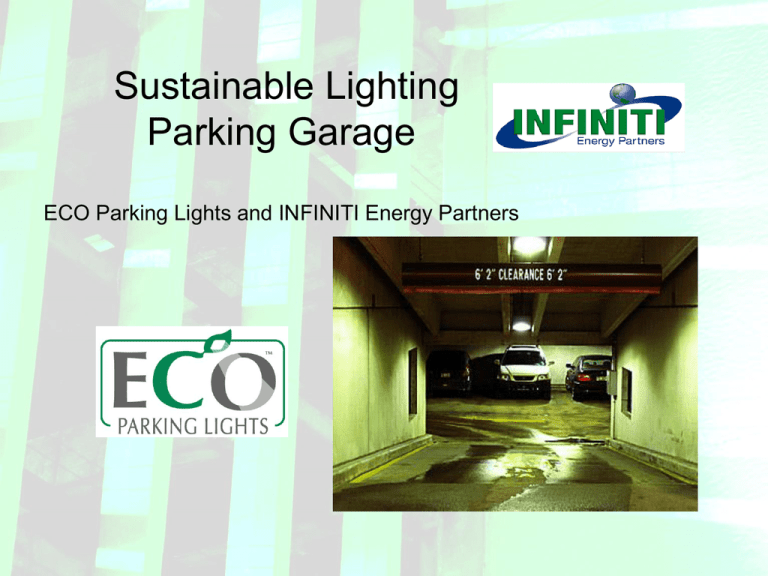
Sustainable Lighting Parking Garage ECO Parking Lights and INFINITI Energy Partners Why is Lighting important? Lighting is the largest source of energy consumption in a parking garage and Is the obvious first choice to address when desiring to reduce energy spend. Historical Lighting Technologies Fluorescent T12 Fluorescent 8’ double = 243 watts per fixture 10,000 to 20,000 hour life Historical Lighting Technologies HID (High Intensity Discharge) Metal Halide 175 watts = 208 watts per fixture 15,000 to 20,000 hour life High Pressure Sodium 150 watts = 180 watts per fixture 20,000 hour life Historical Lighting Technologies HID (High Intensity Discharge) Lamp & Ballast designed to turn off at least one time per day, or suffer premature depreciation Historical Lighting Technologies New Considerations Lighting From Wikipedia, the free encyclopedia Color Properties To define light source color properties, the lighting industry predominantly relies on two metrics, correlated color temperature (CCT), commonly used as an indication of the apparent “warmth” or “coolness” of the light emitted by a source, and color rendering index (CRI), an indication of the light source’s ability to make objects appear natural. These two metrics, developed in the last century, are facing increased challenges and criticisms as new types of light sources, become more prevalent in the market. Historical Lighting Technologies HID (High Intensity Discharge) – Metal Halides Color shift of Metal Halides Depreciation of Metal Halides Historical Lighting Technologies HID (High Intensity Discharge) – High Pressure Sodium Example of CRI and Color Temperature High Pressure Sodium ECO Quad Induction 150 watt 9 foot-candles 100 watt 6 foot-candles Today’s Low Energy Technologies of Parking Garage Lighting Today’s Low Energy Technologies of Parking Garage Lighting Any of the three lighting choices that I will be discussing may be valid and a good choice for your parking facilities. It is important to choose a lighting manufacturer that has a solid history with solid references. Also, consider using suppliers that have more than one type of lighting solution. Your provider should be able to offer the best lighting solution that makes sense for a particular property in a particular market. It is helpful to do a multi-fixture demonstration of the various lighting types as well as various lighting manufacturers before moving forward. All are NOT equal. General commentary on imported products Even if you win a lawsuit against a Chinese lighting manufacturer, unless the manufacturer has significant US holdings, there is no recourse in the US against such a company, your only recourse is against the importer. What is Green about Fluorescent? Green Advantages • Lowest first cost • Low energy – approx. ½ of MH,HPS and T12 • Long life vs. MH and HPS – 2 times length • Low CO2 emissions – about .84 metric tons per fixture per year • Reduced mercury content vs. MH and HPS • Good warranty – 5 year ballast • Major players in lamp technology: Sylvania and Philips • Instant on/off Fluorescent available in T8 and T5 Compact Fluorescents (CFLs) are not included in this category Fluorescent installation What is not so Green about Fluorescent? Green Disadvantages • Highest installation cost (approx. $95 per fixture) • Field assembly required • Reduced performance in very cold climates and open installations if fixture is not designed for cold climates. Typically, T8 is best for cold climates, T5 for warmer climates • Hi maintenance due to size of fixtures, number of lamps per fixture, and perimeter length, can be a bug collector •IESNA min/max standards of 10:1 very difficult to meet in a one-for-one replacement (necessary to qualify for EPACT2005) •Poor end distribution, must design for it •New construction requires more fixtures per square foot than HID, Induction or LED •May need to replace fixture midlife of other technologies What is not so Green about Fluorescent? Poor end distribution off of Fluorescent shown in this actual demonstration installation. Fluorescents are on a 2-2-2-2 pattern Inductions are on a 2-1-2-1 pattern Despite extra Fluorescents, spread is challenged What is Green about Induction? Green Advantages • Low energy – approx. ½ of MH, HPS and T12 • Long life vs. MH and HPS – 6 to 7 times length • Low CO2 emissions – about .84 metric tons per fixture per year • Reduced mercury content vs. MH and HPS • Good warranty – 5 year ballast and lamp (parts and labor) • Major recognizable players: Sylvania and Philips • Long life makes it Most Sustainable of all options • Lowest installation cost with quick mount (approx. $35 per fixture) • Great in cold climates (start at -40C/-40F) • Instant on/off • Excellent for a one-to-one replacement well within IESNA min/max Induction installation – Frederick, MD What is not so Green about Induction? Green Disadvantages • Higher first cost than Fluorescent • Lesser output than some other options • Lesser known and Chinese imports can give bad name •Osram Sylvania patent infringement lawsuit on “Racetrack” design What is Green about LED? Green Advantages • NO mercury content! • Low energy – approx. 60% of MH, HPS and T12 •Very efficient distribution due to point source light • Long life vs. MH and HPS – 3 to 6 times length • Low CO2 emissions – about 1.2 metric tons per fixture per year • Longer life makes it Sustainable • Lower installation cost than Fluorescent • Great in cold climates • Instant on/off • Excellent for a one-to-one replacement well within IESNA min/max • Has a new hi-tech appeal – Lindsey Lumen! LED Installation What is not so Green about LED? Green Disadvantages • Highest first cost • Some have lesser output than other options • Lesser known and Chinese imports can give bad name • History has not defined it’s performance yet •Heat sensitive – traditional fixtures do not have proper heat sink • Warranties are all over the place • Predicted life is all over the place 50K, 100K? • Sample installations with mixed results • If LED is not shielded properly, can be objectionable – “Glare” •LED tubes – poor performers with no history What is not so Green about LED? LED Indoor and Parking Lot and Area Lighting Not Ready for The U.S. Air Force 5.1.1. The Chief Electrical Engineer has also determined LED luminaires are not permitted for exterior applications by UFC 3530-01, Chapter 7. Only metal halide, induction, low-pressure sodium, or high-pressure sodium lamps are to be used in parking lots or area lighting. 7.1. To determine the reliability, maintainability, and appropriateness of LED technology for interior and exterior lighting systems, bases that have already installed LED luminaires before the September 2009 moratorium on LED installation shall provide quarterly reports that assess fixture performance. What about CFLs and LED Tubes? CFLs Low first cost Very short life Warm up period Temperature sensitive Lesser performance (lumens per watt) Do a field test before considering LED Tubes Newest kid on the block No history – what there is – indicates a short life T8 or T5 has longer life and is a fraction of the cost Linear limitations like fluorescent Do a field test before considering How can I pay for a lighting retrofit? • One to one replacements pay off in most markets between 2 to 4 years •EPACT2005 tax credits through 2012 •Municipal lease rates remain attractive •Many legitimate lighting and energy companies offer full financing at attractive rates •Utility rebates – free money •Stimulus funds Questions?

